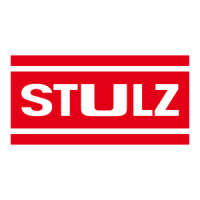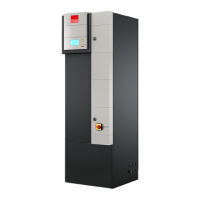Do you have a question about the Stulz Mini-Space DX CCD251A and is the answer not in the manual?
Identifies danger, attention, information, and ESD warnings.
General safety, refrigerant handling, protective equipment, and unit usage.
Classification and safe handling of refrigerants according to EN 378.
Requirements for refrigerating plants, installation, operation, and inspection.
Risks during transport/installation, causes, dangers, and safety notes.
Risks during unit start-up, causes, dangers, and safety notes.
Risks during unit operation, causes, dangers, and safety notes.
Risks during unit maintenance, causes, dangers, and safety notes.
Risks during unit dismantling, causes, dangers, and safety notes.
Information on unit packaging, delivery checks, and consignment notes.
Guidelines for safely moving units with lifting devices and forklifts.
Measures to protect the unit from damage and corrosion during storage.
Explanation of the type code's meaning and location on the unit's rating plate.
Specifies the A/C unit's intended use for indoor temperature and humidity control.
Details unit operation, controller, sensors, and dehumidification process.
Admissible conditions for temperature, humidity, outdoor ambient, and storage.
Electrical connection, static pressure, and return air conditions for technical data.
Values for LP, HP, and safety switches for different refrigerants.
Comprehensive technical data table for various unit models.
Dimensional drawings for Cabinet size 1 and Cabinet size 2 units.
Guidelines for unit placement, clearances, and vibration isolation.
Instructions on accessing the unit's interior for maintenance.
Details on connecting refrigerant, water, and condensate piping.
Design considerations for refrigerant piping between the unit and condenser.
Diagrams and dimensions for refrigerant line connections on various unit types and configurations.
Step-by-step guide for filling the refrigerant circuit and required volumes.
Connecting external water circuit, anti-freezing agents, strainer recommendations, and pipe diameters.
Syphon installation and condensate drain connection procedures.
Safety, cable routing, phase rotation checks, and power supply requirements.
Procedures for initial commissioning, power checks, and contactor verification.
Safety regulations for maintenance, procedure instructions, and warnings.
Recommended maintenance intervals for various unit components.
Checking refrigerant quantity, purity, and handling leaks and overfilling.
Information on compressor oil, expansion valve, and their maintenance.
Heat exchanger cleaning, fan maintenance, and air filter replacement.
Checks for water circuit tightness, condenser cleanliness, and unit integrity.
Lists required competences for repairs on different unit systems.
Lists common alarm messages, their causes, and elimination steps.
Procedures for safely disposing of refrigerant and compressor ester oil.
Steps for disconnecting the unit from external systems and moving it.
Lists unit models covered by the CE declaration and relevant EC directives.
Explains the steam humidifier's function, steam generation, level monitoring, and drainage.
Technical specifications for steam capacity, power, current, and operating conditions.
Wiring diagram for the ECCM/S control unit with component labels.
Settings for capacity limitation, control signal, and general unit parameters.
Details on water supply connections, recommended valves, and pipe types.
Explains the function of display elements: drain/info key, error, warning, and steam LEDs.
Step-by-step guide for commissioning the steam humidifier and performing functional tests.
Explains how LEDs indicate steam output and status in info mode.
Instructions for manually draining the steam cylinder.
Procedures for safely shutting down and disconnecting the steam humidifier.
General advice on fault diagnosis and troubleshooting overview for the steam humidifier.
Describes LED indicators for malfunctions and how to interpret them.
Steps to reset the maintenance indicator after maintenance.
Comprehensive list of malfunctions with LED indications, causes, and remedies.
Procedure for replacing a blown fine-wire fuse on the control unit.
Method to reset the red LED fault indicator after addressing the issue.
Points to detailed maintenance manual and shows steam cylinder life cycle diagram.
Details on Electrical, Hot Water (HW), and Hot Gas (HG) reheat options.
Reheat operation is controlled by the unit's controller.
Instructions for cleaning and checking the reheat for damage.
Information on installing reheats and piping diameters for HW reheat.
Reheat commissioning is handled by the A/C unit controller.
Lists common reheat alarms and their system display indications.
Describes the EU5 filter as an upgrade for improved air filtration.
Details on condensate pump types, operation, and connection to sewage system.
Dimensions for upflow return air suction and filter installation notes.
Describes front air discharge features for downflow units and fin adjustability.
Details dimensions for the air discharge plenum used with upflow units.
Explains the function of the unit base for air discharge and installation requirements.
Provides dimensions for the base used for duct connection and air dampers on upflow units.
Describes the air damper installation on discharge sides of downflow/upflow units.
Shows dimensions for an adaptor plate for mounting air dampers below downflow units.
Details the air damper used on the discharge side of downflow units, requiring an adaptor plate.
Describes the filter top with flexible duct for suction side connection on downflow units.
Illustrates airflow path during free cooling operation with outside air mixing.
Explains the function of the louver actuator NM 24-SR for fresh or return air.
Dimensional drawings for Size 1 Downflow units with Ecocool louvers.
Dimensional drawings for Size 2 Downflow units with Ecocool louvers.
Details dimensions and components for raised floor stands for cabinet sizes 1 and 2.
Illustrates connection types for bars and provides mounting instructions and general design.
Detailed sealing views, mounting louvers, and positioning the unit on the stand.
Explains phase monitoring relay functions, errors, and automatic restart settings.
Details the function of a second power supply option for size 2 units.
Describes automatic commutation between two power supplies for size 1 units.
Provides requirements and table for maximum supply line cross-sections.
Shows a diagram of a refrigerant circuit with hot gas bypass for reduced compressor switching.
Shows a diagram of a refrigerant circuit with suction valve for throttle control.
Explains the use of adjustable HP/LP switches for monitoring compressor operation.
Identifies danger, attention, information, and ESD warnings.
General safety, refrigerant handling, protective equipment, and unit usage.
Classification and safe handling of refrigerants according to EN 378.
Requirements for refrigerating plants, installation, operation, and inspection.
Risks during transport/installation, causes, dangers, and safety notes.
Risks during unit start-up, causes, dangers, and safety notes.
Risks during unit operation, causes, dangers, and safety notes.
Risks during unit maintenance, causes, dangers, and safety notes.
Risks during unit dismantling, causes, dangers, and safety notes.
Information on unit packaging, delivery checks, and consignment notes.
Guidelines for safely moving units with lifting devices and forklifts.
Measures to protect the unit from damage and corrosion during storage.
Explanation of the type code's meaning and location on the unit's rating plate.
Specifies the A/C unit's intended use for indoor temperature and humidity control.
Details unit operation, controller, sensors, and dehumidification process.
Admissible conditions for temperature, humidity, outdoor ambient, and storage.
Electrical connection, static pressure, and return air conditions for technical data.
Values for LP, HP, and safety switches for different refrigerants.
Comprehensive technical data table for various unit models.
Dimensional drawings for Cabinet size 1 and Cabinet size 2 units.
Guidelines for unit placement, clearances, and vibration isolation.
Instructions on accessing the unit's interior for maintenance.
Details on connecting refrigerant, water, and condensate piping.
Design considerations for refrigerant piping between the unit and condenser.
Diagrams and dimensions for refrigerant line connections on various unit types and configurations.
Step-by-step guide for filling the refrigerant circuit and required volumes.
Connecting external water circuit, anti-freezing agents, strainer recommendations, and pipe diameters.
Syphon installation and condensate drain connection procedures.
Safety, cable routing, phase rotation checks, and power supply requirements.
Procedures for initial commissioning, power checks, and contactor verification.
Safety regulations for maintenance, procedure instructions, and warnings.
Recommended maintenance intervals for various unit components.
Checking refrigerant quantity, purity, and handling leaks and overfilling.
Information on compressor oil, expansion valve, and their maintenance.
Heat exchanger cleaning, fan maintenance, and air filter replacement.
Checks for water circuit tightness, condenser cleanliness, and unit integrity.
Lists required competences for repairs on different unit systems.
Lists common alarm messages, their causes, and elimination steps.
Procedures for safely disposing of refrigerant and compressor ester oil.
Steps for disconnecting the unit from external systems and moving it.
Lists unit models covered by the CE declaration and relevant EC directives.
Explains the steam humidifier's function, steam generation, level monitoring, and drainage.
Technical specifications for steam capacity, power, current, and operating conditions.
Wiring diagram for the ECCM/S control unit with component labels.
Settings for capacity limitation, control signal, and general unit parameters.
Details on water supply connections, recommended valves, and pipe types.
Explains the function of display elements: drain/info key, error, warning, and steam LEDs.
Step-by-step guide for commissioning the steam humidifier and performing functional tests.
Explains how LEDs indicate steam output and status in info mode.
Instructions for manually draining the steam cylinder.
Procedures for safely shutting down and disconnecting the steam humidifier.
General advice on fault diagnosis and troubleshooting overview for the steam humidifier.
Describes LED indicators for malfunctions and how to interpret them.
Steps to reset the maintenance indicator after maintenance.
Comprehensive list of malfunctions with LED indications, causes, and remedies.
Procedure for replacing a blown fine-wire fuse on the control unit.
Method to reset the red LED fault indicator after addressing the issue.
Points to detailed maintenance manual and shows steam cylinder life cycle diagram.
Details on Electrical, Hot Water (HW), and Hot Gas (HG) reheat options.
Reheat operation is controlled by the unit's controller.
Instructions for cleaning and checking the reheat for damage.
Information on installing reheats and piping diameters for HW reheat.
Reheat commissioning is handled by the A/C unit controller.
Lists common reheat alarms and their system display indications.
Describes the EU5 filter as an upgrade for improved air filtration.
Details on condensate pump types, operation, and connection to sewage system.
Dimensions for upflow return air suction and filter installation notes.
Describes front air discharge features for downflow units and fin adjustability.
Details dimensions for the air discharge plenum used with upflow units.
Explains the function of the unit base for air discharge and installation requirements.
Provides dimensions for the base used for duct connection and air dampers on upflow units.
Describes the air damper installation on discharge sides of downflow/upflow units.
Shows dimensions for an adaptor plate for mounting air dampers below downflow units.
Details the air damper used on the discharge side of downflow units, requiring an adaptor plate.
Describes the filter top with flexible duct for suction side connection on downflow units.
Illustrates airflow path during free cooling operation with outside air mixing.
Explains the function of the louver actuator NM 24-SR for fresh or return air.
Dimensional drawings for Size 1 Downflow units with Ecocool louvers.
Dimensional drawings for Size 2 Downflow units with Ecocool louvers.
Details dimensions and components for raised floor stands for cabinet sizes 1 and 2.
Illustrates connection types for bars and provides mounting instructions and general design.
Detailed sealing views, mounting louvers, and positioning the unit on the stand.
Explains phase monitoring relay functions, errors, and automatic restart settings.
Details the function of a second power supply option for size 2 units.
Describes automatic commutation between two power supplies for size 1 units.
Provides requirements and table for maximum supply line cross-sections.
Shows a diagram of a refrigerant circuit with hot gas bypass for reduced compressor switching.
Shows a diagram of a refrigerant circuit with suction valve for throttle control.
Explains the use of adjustable HP/LP switches for monitoring compressor operation.
| Brand | Stulz |
|---|---|
| Model | Mini-Space DX CCD251A |
| Category | Air Conditioner |
| Language | English |











